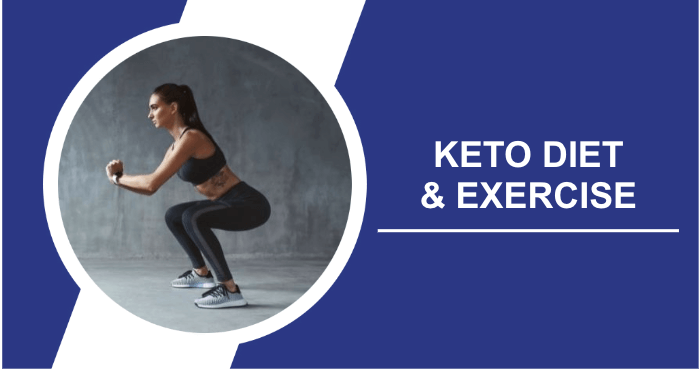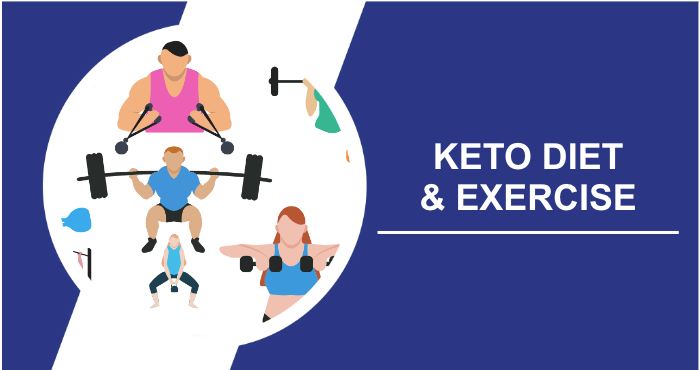Incorporating the Keto Diet and implementing exercise routines can be a fantastic combination to help you achieve your health and fitness goals. This powerful duo not only helps with weight management, but also improves overall well-being and energy levels.
The ketogenic diet, also known as “keto diet” has become popular for its ability to promote weight loss by relying on fat as the source of energy instead of glucose. Exercise has always been a part of weight loss programs and is crucial for building muscle mass.
Extensive research on exercise has identified types that are most effective for shedding pounds. However a vital question remains: Can a keto diet provide energy for these exercise routines?
Does Exercise Accelerate Weight Loss In Ketosis? When following a keto diet the body enters a state called ketosis. The impact of exercise on this process varies depending on the type performed. Low intensity workouts that elevate heart rate without requiring bursts of energy can facilitate the transition to ketosis without straining the body.
Although it may be possible to resume the same level of exercise intensity maintained prior to starting the keto diet it is recommended to prioritize lower intensity workouts initially. Gradually reintroducing high intensity exercises, in the run is a sensible approach.
What Exactly Is a Keto Diet?
The keto diet is often described as a culinary journey for the adventurous. It takes you into the world of fats and low carb living. Think of your body as a detective that switches from relying on carbohydrates to using stored fats for energy.
It’s like solving a puzzle while indulging in avocados, nuts and flavorful steaks all while saying goodbye to sugary temptations. This dietary path not changes your eating habits but also unlocks mental clarity and long lasting vitality making you feel like an explorer whos conscious, about their health discovering new possibilities within your own body.
What Should I Be Aware of When Following a Ketogenic Diet?
Embarking on a weight loss journey is like embarking on a unique nutritional adventure but there are some important considerations to keep in mind. Your body, as the captain of this voyage requires hydration and electrolytes as it adapts to the new path. Be prepared for whats referred to as the “keto flu,” which might bring about temporary fatigue and cravings in the initial stages.
As you make your food choices take pleasure in the array of carb delights available but be cautious of hidden sugars that may be lurking in unexpected places. Remember that long term success on this journey relies on finding balance with your macronutrients, thoughtful planning and paying attention to your bodys signals.
Keto Exercise: Recommended Workout Choices

When starting a keto diet it’s important to prioritize effective workouts. Of high intensity routines focus on low to moderate intensity aerobic activities like jogging, biking or swimming. These exercises are choices especially when you’re still adjusting to the low carb diet.
As you get more used to the keto lifestyle you can consider adding higher intensity workouts into your routine. However it’s essential to proceed with caution. Activities such, as weightlifting or calisthenics may feel more challenging. Make sure to transition into these higher intensity exercises and be mindful of any new limitations you might come across.
Top Exercises to Aid Weight Loss on the Keto Diet
Moderate-Intensity Aerobic Exercise
Engaging in moderate intensity aerobic exercises is often recommended for individuals on a ketogenic diet. These exercises involve raising your heart rate to 50 – 75% above its resting rate for a total of 150 minutes per week qualifying them as moderate intensity workouts.
Various activities fall under this category, such as jogging, practicing yoga going for a bike ride or engaging in moderately paced freestyle swimming. These exercises not contribute to cardiovascular health and endurance but are also suitable for those who have reduced carbohydrate intake.
High Intensity Interval Training (HIIT)
Another effective exercise option is high intensity interval training (HIIT) which involves alternating between bursts of intense exercise and longer intervals of lower intensity activity. For instance a typical HIIT session may consist of two 30 second intervals of high intensity sprinting followed by a 15 second interval of walking repeated until exhaustion.
While HIIT offers weight loss benefits the specific amount required can vary from person, to person. Additionally it’s worth noting that some individuals might find it challenging to perform high intensity intervals while following a keto diet. It’s crucial to understand the limitations of your body and refrain from exerting yourself beyond a threshold in order to prevent any potential injuries.
Building Lean Muscle Mass through Strength Training
When it comes to building muscles weight training is a part of any workout routine. This type of exercise focuses on pushing your muscles to their limits and allowing them to recover before subjecting them to further stress. Over time this progressive resistance leads to muscle growth. For individuals following low carb diets like keto strength training can pose challenges especially when it involves fast repetitions with heavy weights.
If you’re on a keto diet it’s advisable to choose strength training programs that prioritize maintaining muscle tone than aiming for rapid muscle mass gains. When starting a keto diet its recommended to begin with a focus, on strength training. It’s important to keep in mind that if your ultimate goal is muscle mass gain you should gradually work towards achieving that goal.
The Positive Impacts of Following a Ketogenic Diet on Athletic Performance
Increased Fat Metabolism
The ketogenic diet has gained popularity due, to its ability to trigger ketosis, a metabolic state where the body utilizes fat as an energy source instead of carbohydrates (sugar). When combined with exercise this diet is believed to enhance fat burning by expediting the depletion of carbohydrate based energy reserves.
Enhanced Muscle Recuperation
Muscle building workouts aim to rebuild and restructure muscle cells and fibers within the tissue. During periods of rest muscles that have been stressed through exercise undergo a recovery process that involves self repair and the generation of muscle fibers.
Ketogenic diets can potentially speed up this process especially because the liver produces bodies during ketosis when it metabolizes fat for energy. This metabolic state has been found to enhance muscle recovery by aiding in the replenishment of muscle glycogen stores.
Enhanced Stamina
Although high intensity exercise might be more challenging while following a ketogenic diet there is evidence suggesting that individuals on this eating plan may experience extended endurance during low or moderate intensity workout sessions. These findings have been observed in endurance athletes like marathon runners and multistage cyclists.
Furthermore it is believed that ketogenic diets, which are rich in fatty acids promote increased oxidation. This process involves breaking down acids to generate energy, for the body.
Tips to Follow When Exercising on a Keto Diet
Here are some tips to keep in mind when exercising on a diet:
Determine Your Calorie Target
One important aspect of combining exercise with a keto diet is establishing your daily calorie goal. Remember that 3,500 calories equal one pound of body weight. If you aim to lose one pound per week reducing your caloric intake by 500 calories is a good starting point.
For rapid weight loss it’s advisable to seek guidance from a healthcare professional. Additionally you can consider factoring, in the calories burned during exercise as part of your calorie reduction strategy. Various apps are available to assist you in setting and achieving your calorie goals so take the time to research and find the calorie tracker app that suits your requirements.
Stay Well Hydrated
When we exercise our bodies tend to sweat more which can lead to dehydration as we lose water. To prevent dehydration it’s crucial to increase our water intake.
Drinking an amount of water not only helps prevent dehydration but also enhances our endurance and ensures that our heart doesn’t have to work too hard during physical activity. The specific quantity of water needed varies from person to person. A general guideline is to aim for approximately eight glasses per day.
Eat Enough Protein
Additionally protein plays a role, in our daily diet and becomes even more essential when we engage in regular exercise. If you’re limiting your protein sources in your food intake one option is to consider incorporating protein powder into your routine. Protein powders come in flavors and can be mixed with milk or other liquids. These products offer levels of protein content catering to individual preferences and dietary requirements.
Avoid Overexertion
It’s important to keep in mind especially if you’re new to the keto diet that your physical abilities might be slightly affected. Don’t push yourself hard to match your previous level of activity. During the weeks focus on workouts with lower intensity since you might experience a decline, in performance. As you gradually adjust to the keto diet take steps towards reaching your desired level of exercise intensity.
How Can I Enhance My Performance While On a Keto Diet?
Keto diets can vary in terms of the percentages of macronutrients (fat, carbohydrates and protein) and how strictly these percentages are maintained. There are keto variations designed for different types of exercises which we will discuss below.
- The Targeted Ketogenic Diet (TKD) is similar to the Cyclical Ketogenic Diet (CKD). It allows for the consumption of carbohydrates at any time particularly when engaging in higher intensity workouts. During times individuals follow a standard ketogenic diet. 25 50 mg of carbohydrates mainly in the form of glucose and dextrose are consumed 30 minutes prior to exercise. Many people use glucose tablets, which are commonly used by individuals managing diabetes to regulate their blood sugar levels. Additionally the targeted ketogenic diet emphasizes avoiding intake immediately before and after exercising.
- The Cyclical Ketogenic Diet (CKD) involves maintaining a diet for five days each week and then having two days with increased carbohydrate intake. During these two high carbohydrate days ketosis is not maintained, allowing for intense exercise on those specific days. This diet is popular among individuals who aim to build muscle.
- The High Protein Ketogenic Diet (HPKD) is specifically designed for bodybuilders and weightlifters. In this diet 30% of the daily calorie intake comes from protein. For instance on a 2,500 calorie per day diet for males this amounts to 750 calories or over 83 grams of protein, per day. Considering the higher protein needs that come with bodybuilding routines it makes sense to increase protein consumption. However individuals who have kidney issues should avoid high protein diets.
Supplements to Enhance Exercise Performance While Following the Keto Diet
Creatine
Creatine is a natural amino acid found in muscles. Its main role in the body is to support the recycling of compounds that provide energy for bodily functions. By increasing your intake of creatine you can boost your energy reserves as well as promote muscle mass and growth.
Protein Powders
Protein powders come in flavors and concentrations and are derived from various sources. The common protein sources used in these powders are soy and whey. However if soy and whey proteins don’t align with your needs there are alternative protein sources available for powder manufacturing such, as peas, hemp and eggs.
Pre Workout Supplements
Consider incorporating a workout supplement into your daily workout routine. These supplements often contain creatine along with amino acids and caffeine which can provide an extra boost of energy.
Additionally they typically include nitric oxide, which enhances oxygen uptake and blood flow to the muscles ultimately improving endurance. It’s an idea to try out different supplements before settling on one that works best for you on a regular basis.
What are the best exercises for a keto diet?
When it comes to staying fit while following a keto diet envision your body as a machine that efficiently burns fat. Optimal exercise becomes your trusted companion in this journey. Imagine low intensity activities such as walking or yoga as the soothing hum of an engine promoting relaxation and encouraging fat utilization.
On the hand high intensity workouts like weightlifting and sprinting supercharge your metabolism and give you a sense of invincibility. Remember, consistency and paying attention to your bodys cues are key factors, in guiding you on this unique keto powered fitness adventure where you can embrace challenges and achieve success whether its gracefully flowing through yoga poses or setting new weightlifting records.
What Side Effects Can a Keto Diet Have?
Embarking on a keto diet can feel like embarking on an adventure but its not always smooth sailing. As your body adapts to this way of fueling itself you might experience something known as the “keto flu.” During this phase you may feel fatigued or have mood swings, which can temporarily cloud your journey.
Some people also encounter side effects, like bad breath (referred to as “keto breath”) or potential digestive issues. However don’t worry! These are just passing obstacles in your keto journey. By staying hydrated replenishing electrolytes and taking an planned approach you can navigate through these challenges and reach the brighter shores of ketosis.
Conclusion
Both following a keto diet and engaging in exercise are methods for weight loss, fat burning and overall fitness maintenance. Combining these two approaches allows you to reap the health benefits they offer.
However if you’re starting a keto diet while already exercising (or beginning an exercise routine while following keto) it’s important to begin at a lower intensity level. This gives your body time to adapt to the changes before gradually increasing the intensity, over time.
Frequently Asked Questions
Can I exercise on a keto diet, and is it effective for weight loss?
Absolutely! Exercise and keto can work hand in hand for weight loss and overall health. While it might take some adjustment initially, many people experience excellent results when combining the two.
Will I have enough energy for workouts on keto?
Initially, you might notice a decrease in energy due to your body adapting to ketosis. However, as you become keto-adapted, you can maintain energy levels for workouts. Consider targeted ketogenic diets for added support.
How do I find the right balance between keto and exercise for my goals?
The key is to start slowly, let your body adapt, and consult a healthcare professional or nutritionist for personalized guidance based on your specific goals and needs.
Can I build muscle on a keto diet?
Yes, you can build muscle on keto! Just be mindful of your protein intake and consider high-protein keto variations if your goal is muscle growth.
Can I lose weight faster by exercising intensely on keto?
While intense exercise can boost weight loss, it’s crucial to find a balance. Extreme intensity might be challenging on keto, so gradual progress is key.
Resources
- McSwiney, F.T., Wardrop, B., Hyde, P.N., LaFountain, R.A., Volek, J.S., & Doyle, L. (2018). “Keto-adaptation enhances exercise performance and body composition responses to training in endurance athletes.” Metabolism-clinical and Experimental, 81, 25–34. doi:Link.
- Journal of the International Society of Sports Nutrition. (2019). “Effect of a four-week ketogenic diet on exercise metabolism in CrossFit-trained athletes.” Link.
- Ma, S. and Suzuki, K. (2019). “Keto-Adaptation and Endurance Exercise Capacity, Fatigue Recovery, and Exercise-Induced Muscle and Organ Damage Prevention: A Narrative Review.” Sports, 7(2), 40–40. doi:Link.
- Cox, P.J., Kirk, T., Ashmore, T., Willerton, K., Evans, R.D., Smith, A.A., Murray, A.J., Stubbs, B.J., West, J.A., McLure, S., King, M., Dodd, M.S., Holloway, C., Neubauer, S., Drawer, S., Veech, R.L., Griffin, J.L., & Clarke, K. (2016). “Nutritional Ketosis Alters Fuel Preference and Thereby Endurance Performance in Athletes.” Cell Metabolism, 24(2), 256–268. doi:Link.
- Stokes, T., Hector, A.J., Morton, R.W., McGlory, C., & Phillips, S.M. (2018). “Recent Perspectives Regarding the Role of Dietary Protein for the Promotion of Muscle Hypertrophy with Resistance Exercise Training.” Nutrients, 10(2), 180–180. doi:Link.
Jayson Peterson is an experienced pharmacist, naturopathic physician, medical examiner, and minister. After earning his Doctor of Pharmacy degree from the Medical University of South Carolina, Jayson Peterson completed clinical rotations at several prestigious healthcare institutions and has been affiliated with several pharmacy chains throughout his career. His main passion and zeal is focused on providing world-class patient care by giving precise details and thorough instructions to those who need it most.

